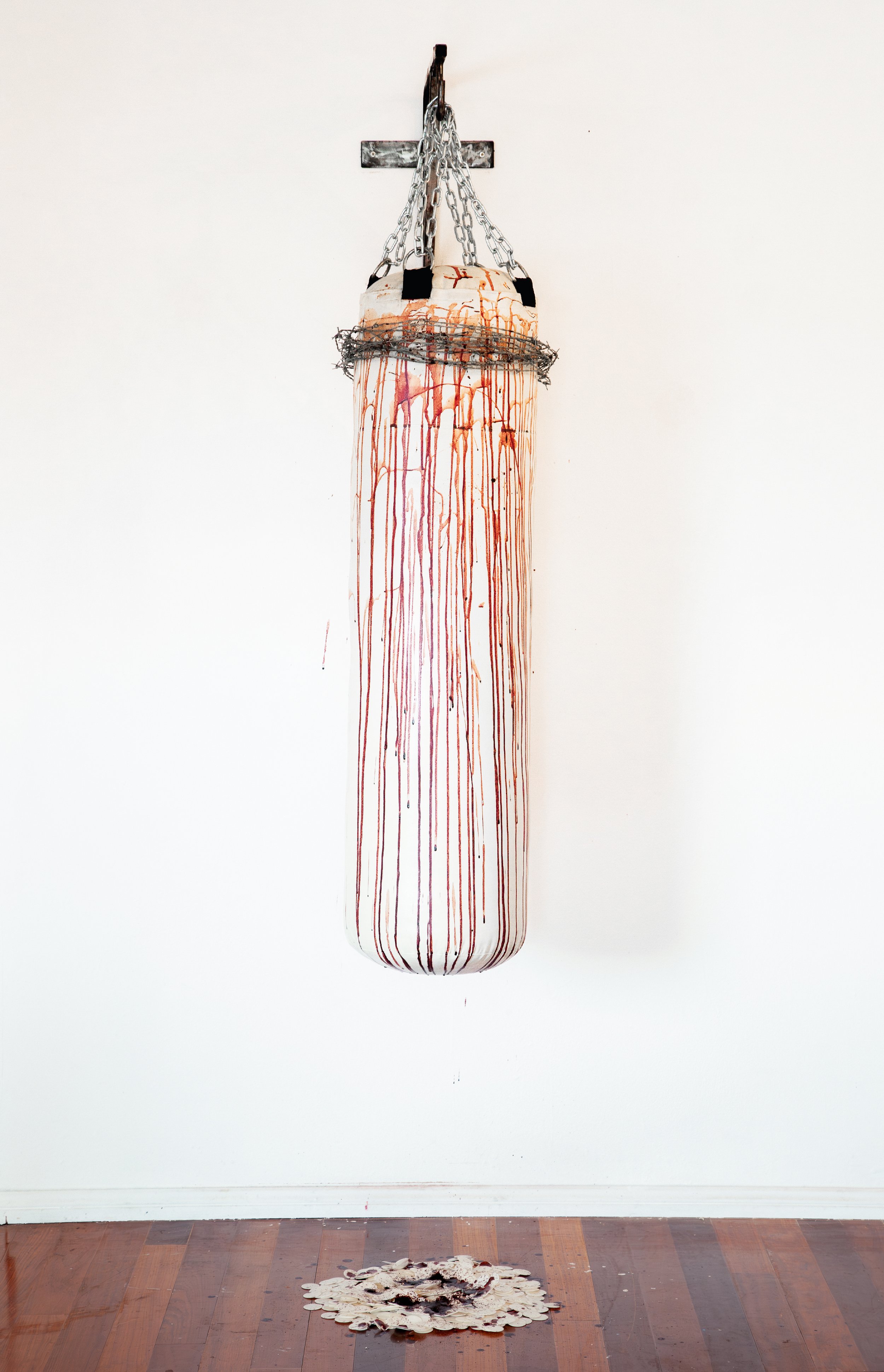I Wish God Was Alive To See This
A solo exhibition of works by Wade Kelly
Nano Gallery
2022
You Are The Prototype, 2022
Acrylic on canvas
296cm x 61.5cm
Corpus Christi & The Absent Father, 2022
Punching bag, barbed wire, chain, steel, altar bread, artists’ blood
157cm x 55cm x 30cm
Detail
Detail
Advanced Meditation, 2022
Fibreglass statue, glass, selfie stick, apples, iPhone, continuous livestream to Instagram live
83cm x 90cm x 45cm
Installation view
Suspension Of Disbelief, 2022
Stainless steel, hardcover books, hardware
180cm x 120cm x 50cm
Detail
Self Portrait Past Tense, 2022
Biometric passport photo, City of Sydney parking fine, biological waste bag, hypodermic syringes, artists’ blood on board
110cm x 90cm
Detail
Detail
You Can’t Take It With You, 2022
Bread
283cm x 13cm x 13cm
Being This Close To God Should Be A Sin, 2022
Plastic chairs, epoxy, found wine bottles
283cm x 50cm x 50cm
Detail
The People’s Champ, 2022
Ink on found cardboard print, inkjet print in found frame
57.5cm x 44.5cm
This is not a show about faith. It’s about the scorched terrain left behind in its absence—and what gets built there, with whatever fragments remain. In our era of ambient belief and algorithmic identity, faith has become optional. But symbols endure. In I Wish God Was Alive To See This, they are not simply referenced—they are wounded, worn, and made real.
At the heart of the exhibition hangs Corpus Christi: a white punching bag, suspended by chains, encircled with a barbed-wire halo, slicked and dripping with the artist’s own blood. Beneath it, real communion wafers soak in a dark, sacramental puddle. This is not metaphor—it is sacrifice. A literal offering of the body to image. The work does not illustrate trauma; it enacts it.
In a culture numbed by simulation, the gesture lands with visceral force. It dares sincerity. It rejects irony. Corpus Christi becomes both altar and assault—a crucifixion in the absence of divinity. Christ is not returning. So the artist bleeds in His place.
Nearby, You Can’t Take It With You constructs a crumbling tower of bread. A stairway to heaven made from the most basic of offerings—humble, perishable, and holy. But here, Eucharist doubles as commodity, and the dream of transcendence is recast as capitalist striving. The altar becomes a monument to delusion.
In Advanced Meditation, a golden Buddha livestreams his own enlightenment into digital oblivion. Affirmations like “LIVE LAUGH LOVE” and “GODSPEEDSUPERFREAK” ghost across the walls—depleted mantras of late-capitalist spirituality. These aren’t texts; they are residues. Echoes in a cathedral already empty.
Being This Close to God Should Be a Sin presents two plastic chairs: one grounded atop a stack of wine bottles, the other floating just above shattered glass. The bottles recall sacrament and intoxication; the chairs suggest both collapse and ascent. From this precarious altar, a question rises: Why shouldn’t the sacred live in a bottle of cheap wine? Or in a broken plastic chair? Grace does not ask permission. Sometimes, transcendence appears in the places we’re taught to overlook.
Parody it is not. Nor is it a call to worship. It is a reckoning. A private rite made public. A blood offering in a white cube. A funeral for the sacred—but also a kind of resurrection. Not of God, but of the questions God once answered.
If belief has evaporated, this exhibition captures the humidity left behind. These works do not offer solutions. They testify. They perform. They bleed. And in doing so, they risk feeling something sacred again—raw, absurd, and frighteningly sincere.














